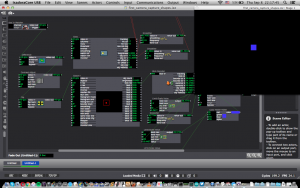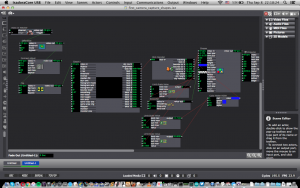Posted: September 15, 2016 Filed under: Uncategorized Leave a comment »
My pressure project began very ambitiously. The idea was to use the Webcam, the Eyes++ Actor and Isadora’s sound recognition actors to have users interact with the scene to the beat of the music. However, my PC’s webcam would often misbehave and the system would lag as I attempted to run all of these actors in conjunction, especially when I attempted to incorporate chroma key-based tracking and interactions. The focus of the idea was heavier on sound rather than webcam interactions, thus I scrapped the webcam element and made the process interact with the sound and only sound.
Interestingly, the reaction to the project in action during class lead to my peers wishing me to turn the music off, so they could interact with the scene using their own voices and claps of the hand. It was an unexpected outcome, indeed.
The Things #1
Posted: September 15, 2016 Filed under: Uncategorized Leave a comment »First
That thing I was talking about in class.
related to that Currents International New Media is an awesome place to intern, like i did this summer, and also to present work. It is small but truly a one of a kind place.
Second
Get tickets to Driscoll and 3 Acts 2 Dancers 1 Radio Host.
The Fly
Posted: September 15, 2016 Filed under: Pressure Project I, Robin Ediger-Seto, Uncategorized Leave a comment »This is Fly
Make sure your camera is on.
Try clapping at it.
https://www.dropbox.com/s/rx077164kz1ikai/fly.izz?dl=0
I had no clue what I was going with this, to the point that I was frustrated, and then I realized that this frustration could be one of my resources. One of the more frustrating things in this world are flies. Inspired by these creatures and the need to use the Eyes ++ actor I created a Digital fly the moves when you move and then rest on the last thing that moved, presumably you. I am not a computer programmer and the logic to make this work took most of my time. They need to use The jump actor forced me consider how to progress the story. As flies of the most annoying thing in the world (maybe slight hyperbole) the most satisfying thing (again hyperbole) is to get them. I integrated a system whereby the scene would jump when movement is detected around the fly and a sound is as loud as a clap is heard. To capture to frustration created by a fly I made it so that ones you killed it more would show up. Well doing this I made a scene in which a fly would just fly around. The previous scene jumps to at one time and I decided it was fly heaven and get back to it you have to apologize. I worked up kinks and counter actors as well as made it one more pretty and here is Fly.
Once I finish this assignment I wondered if it was generative. I came to the conclusion is not completely generative. They are fairly basic set outcomes however how you get there is different. The user has a score but what they do can differ. Also, the aspects of the fly are completely randomized including movement and color.
MuBu (Gesture Follower for Sound/Motion Data)
Posted: September 13, 2016 Filed under: Uncategorized Leave a comment »Hello all,
Here is a link to the audio/gesture recognition software I mentioned in class today. These are external objects for Max/MSP. If you don’t have a license for Max, you should be able to open the help patches in Max Runtime or an unlicensed version of Max/MSP (similar to Isadora, you’ll be able to use it but not able to save).
I found out that there is a version for Windows, but it’s not listed under the downloads; once you navigate to downloads, you’ll need to view the archives for MuBu and download version 1.9.0 instead of 1.9.1. I’ve never used it on Windows so I’m not sure how well it works, but I thought this could be of use to someone.
http://forumnet.ircam.fr/product/mubu-en/
Cirque du Soleli Media Workshop
Posted: September 13, 2016 Filed under: Uncategorized Leave a comment »Hello everyone, here’s a link to the Cirque du Soleli Media workshop I mentioned in class today: http://www.capital.edu/cirque/
SOLAR
Posted: September 13, 2016 Filed under: Uncategorized Leave a comment »Imagine entering a machine, supplying the co-ordinates of a city and a specific moment in time and as a response you receive the direction, the intensity and the sensation of heat and light that the sun radiated in that time-space.
This is a piece I saw in Ars Electronica, I hope you guys find it useful for your projects.
Axel
RSVP
Posted: September 13, 2016 Filed under: Reading Responses Leave a comment »Resources: human& physical resources and their motivation& aims.
Scores: process leading to the performance. Plan. Code.
Valuaction: analyzes the results of action and possible selectivity& decisions. Action/decision oriented. Feedback.
Performance: resultant of sources and is the “style” of the process.
I liked thinking of the scores as “symbolizations of processes which extend over time.”
Scores/Process derive essential qualities from a deep involvement in activity. Scores communicate process, making it visible.
Feedback. Analysis is needed before, during, and after for growth and change.
ICEBERG!! This concept is important to me. How do we read the bottom of the ice berg in works (performance/art). “9/10 invisible but vital to achievement”
Dichotomy between score/performance has been on my mind and in my work for a while. Still figuring it out, maybe it’s not a dichotomy, but simply plan/instance – still, there is so much embedded in the instance of performance and all that has proceeded.
“human communications – including values and decisions as well as performance – could be accounted for in process”
Scores – it’s about what the score controls and what is left to chance; what is determinate and left indeterminate / variables of foreseen and unforeseeable events; and to the feedback process which initiates a new score.
Scores are ways of symbolizing reality — of communicating experience through devices other than the experience itself.
first score, then performance – inextricably interrelated
Space / Time / Present / Future
Inner and Outer Motivational Worlds
“When the word as a scoring device becomes a generator of feedback between people rather than an ordering or injunctive mechanism” “Vast new areas of understanding open up…”
“Valuaction in the cycle is operating to the exclusion of the score itself. New understandings of how “active listening procedures” and “congruent sending messages” can “open up” dialogue are at the core of the new view of words as communicative rather than controlling devices.” (emphasis mine)
Ongoingness *relationship to the future
-Multiplicity of input as our guides.
“The established scoring techniques determine what the limits of the art form can be.”
First Video Tracking Demo
Posted: September 8, 2016 Filed under: Uncategorized Leave a comment »Here are some screenshots from my first attempts at controlling a shape using the eyes++ actor from in class today. A blob is tracked, and its vertical and horizontal centers determine the horizontal and vertical position of the square. The object width and height are used to control the red and green color values of the square, and the object velocity is used to control the line size of the square.


Explosive Dots Paper and Pen Game
Posted: September 8, 2016 Filed under: Pen and Pencil Games Leave a comment »Per part of an in-class exercise, Ashely and I decided to improve upon the game that many refer to as Dots. In traditional dots, you make a grid of dots on a piece of paper, and each player takes turns drawing lines to connect them. When a player completes a box, they get a point and take an additional turn. The game ends when the grid has been filled with boxes.
To improve upon this game, we added two rules. The first rule is that when a player completes a box, instead of taking an additional turn, they can instead erase one line on the grid, as long as it is not part of a completed box. The second rule is that whenever a player creates a 2×2 cube of boxes, they can “bomb” any box that belongs to their opponent. This erases all of the lines of that box and all other adjacent boxes of theirs, as long as they do not belong to the player dropping the “bomb.”
In gameplay, it is actually fairly rare to get to “drop a bomb.” However, as observed in play-testing, the simple fact that this rule exists significantly changes the way in which the game is played. Whereas in traditional Dots, there comes a point where players need to draw lines that will certainly give a box (or boxes) their opponent, in Explosive Dots the tension is much greater and requires greater thought and strategy to be sure that you do not give your opponent the proper boxes to form the 2×2 cube. This also offers a possibility for redemption. Because of this, a game can last much longer, as large portions of the grid can be reset, allowing for another player to take the lead.
The game I got to test-play was titled Hangman’s Revival. As the title suggests, it is based on the classic Hangman game, only in this version, if you get two letters correct in a row, you earn “extra lives” which can be used if the entirety of the stick-figure person is drawn before you can guess all of the letters. At first, we played using fairly common words with no more than seven or eight letters before we ran out of time for this activity during class. It was right at the end of this that I realized that this game would be very effective when playing using long, complex, or uncommon words. Had we had more time in class I may have opened up a dictionary and found a word at least twelve letters long.
Danny Coyle’s game project: Green Hill Paradise – Act 2
Posted: September 8, 2016 Filed under: Uncategorized 1 Comment »This is a video game/research project of my own design inspired by the Sonic the Hedgehog game series.
——————————–
Green Hill Paradise was born out of a question. A question that has all but torn the Sonic the Hedgehog community asunder:
Can a Sonic the Hedgehog game be made such that it supplies a rich and robust experience in a fully 3D environment while staying true to its platforming roots?
We are here to answer this question, not through an in-depth analysis video, not through a lengthy forum post, but through a fully playable video game experience. After 10 months of research and development we believe that, yes, Sonic can not only exist in 3D, but he can THRIVE in it. GHP’s massive environment, winding paths, dynamic physics and hidden collectibles provide players with the freedom to choose where they want to go and how they wish to get there. The only limitations are the laws of physics and the player’s own skill.
No Spline paths.
No Boostpads.
No scripted cameras.
No Boost Button.
Gotta Go Fast?
Earn it.
——————————–
Since the game’s release, it has been featured on various websites and YouTube “Let’s Play” videos. I figured it was prudent to share it here with you all as well. If you have any questions about the project, just ask!